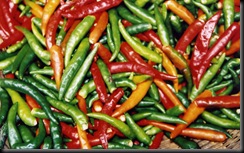There's a fungus among us chili fans—and some of the spicy peppers evolve their kick to repel it, a new study says.Chili peppers develop piquant chemicals to thwart the harmful microbes long enough to give birds and other animals a chance to disperse the pepper seeds, helping the chilies to procreate, scientists found.
Chilis high in chemicals called capsaicinoids occur most in areas where the fungus can enter the peppers through holes bored by insects, and these chilies are hotter, said study author Joshua Tewksbury, a biologist at the University of Washington in Seattle.
Gradient of Hotness
Tewksbury made the discovery after learning that some species of wild chilies in Bolivia have both pungent, spicy individuals and others that lack any kick whatsoever. "You can't tell them apart unless you chew on the fruits," he said.
Chewing on fruits—tough field work, Tewksbury joked—helped the team to establish a gradient of hotness along a 185-mile-long (300-kilometer-long) sample area in Bolivia. The northern end of the line is dominated by nonpungent chilies. The southern populations are much denser and hotter—really hot.
When the team examined fruits from along this transect, they found the pungent ones also had a greater concentration of scar damage from foraging insects similar to aphids and leaf hoppers. The skin on fruits, Tewksbury explained, is a first line of defense against microbes, which can't get past it on their own.
"Every time a bug pokes a hole in the chili fruit, the fungus can get in. And the more times the bugs can poke holes in the fruit, the more likely it is the fungus will start to invade," he said. Laboratory experiments showed capsaicinoids thwart the fungus invasion—but not the insects. "It looks like this chili is hot to stop the fungus, and the fungus is sort of mediated by these bugs," Tewksbury said.
Why Humans Eat Chilies
The finding, he said, adds weight to a hypothesis that humans first started to eat chilies for their antimicrobial properties. He noted that the majority of people who eat chilies live along the Equator, a region of the world where microbes also flourish and cause a range of intestinal diseases.
"We're simply co-opting the result of a very ancient evolutionary arms race between chilies and fungus and saying that will work for us too," he said.Linda Perry, an anthropologist at the Smithsonian Institution's National Museum of Natural History in Washington, D.C., said the new research clearly demonstrates that capsaicinoids evolved to thwart the fungus.
But the study does not show that capsaicinoids prevent foodborne illnesses or act as a preservative, said Perry, who is an expert on the domestication of chilies. Nor, she added, has it been demonstrated that the purported antimicrobial properties of chilies have much to do with their popularity. "I think people probably adopted chili peppers into their diet just because they taste good," she said.
Source: Nationalgeographic


No comments:
Post a Comment